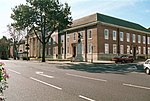Thieves Kitchen
1839 establishments in EnglandBuildings and structures in WorthingFormer churches in West SussexGrade II listed pubs in West SussexGreek Revival architecture in the United Kingdom ... and 1 more
Worthing

The Thieves' Kitchen (formerly Vintner's Parrot and before that Thieves Kitchen) is a pub in the centre of the town and borough of Worthing, West Sussex. Established as a public house in the late 20th century, it occupies two early 19th-century listed buildings in the oldest part of the town: a Greek Revival-style former wine merchants premises, and a Neoclassical chapel built for Wesleyan Methodists in 1839. The main part of the pub is in the wine merchants building facing Warwick Street, while the old chapel (usually called Bedford Hall), facing Bedford Row, serves as its function room. Both buildings have been designated separately as Grade II Listed Buildings.
Excerpt from the Wikipedia article Thieves Kitchen (License: CC BY-SA 3.0, Authors, Images).Thieves Kitchen
Marine Place,
Geographical coordinates (GPS) Address Nearby Places Show on map
Geographical coordinates (GPS)
| Latitude | Longitude |
|---|---|
| N 50.8116 ° | E -0.3693 ° |
Address
Marine Place
Marine Place
BN11 3DL
England, United Kingdom
Open on Google Maps










